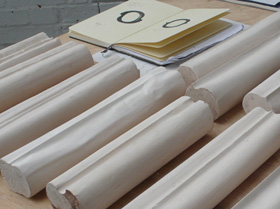02 Apr Juliet Haysom: Lake Shore Development Commission, Bristol

Urban Splash is transforming the derelict former Imperial Tobacco UK Headquarters in Heartcliff, Bristol, into a new mainly residential development called Lake Shore. Architects Acanthus Ferguson Mann are leading the design team. Atelier 10 are the M&E consultants. Ginkgo Projects are the Art Consultancy for the development. Juliet Haysom’s commission is one of three site-specific public art projects commissioned by Urban Splash to accompany the development. It will be located within the site’s extensive 10-acre landscaped grounds, which include wildlife meadows, numerous mature tree and a large man-made lake that extends beneath the main building. Juliet is working closely with the project’s engineers and architects to make a series of bronze rails that will run through the landscape and beside the lake, with a total length of approximately 70 metres. The rails will be plumbed into the building’s ingenious ground source heating system, which provides environmentally sustainable heating, hot water and cooling for the development’s offices and 364 apartments. A vital part of the heat exchange system is the return of heat to the ground, and the rail will perform this function during the summer. Working in parallel with the building’s air conditioning system, fluid pumped through the rails will be warmed by the sun before carrying the heat to be stored under ground. Juliet is investigating the possibility of extruding the rails’ form in wax and on site at Lake Shore before having them cast into bronze. This method will allow for a finished object that is tactile, fits the landscape perfectly, and will ensure that the rails maintain an immediacy often lost in large-scale work.
The design phase, started in summer 2007, was concluded in January 2008. The sculpture is due for completion in Autumn 2008.
Juliet says: “My approach to making use of latent aspects of a place (in this case, the geothermal heating system integrated into the redeveloped 1970s building and its surrounding landscape) and employing material processes (thermal transfer via pumped fluids) has much in common with previous sculptural projects. However, rather than making use of ready-made equipment, I will be modifying the bronze casting process itself. Warm wax will be extruded through a bespoke die to form hollow lengths. These will then be cast directly, eliminating the usual mould-making stages. This adaptation will lend the process an immediacy and tactility, as I will have to skillfully manipulate each length into the required curves before the wax cools. This will take practice, but I now have a better understanding of what that means.”





